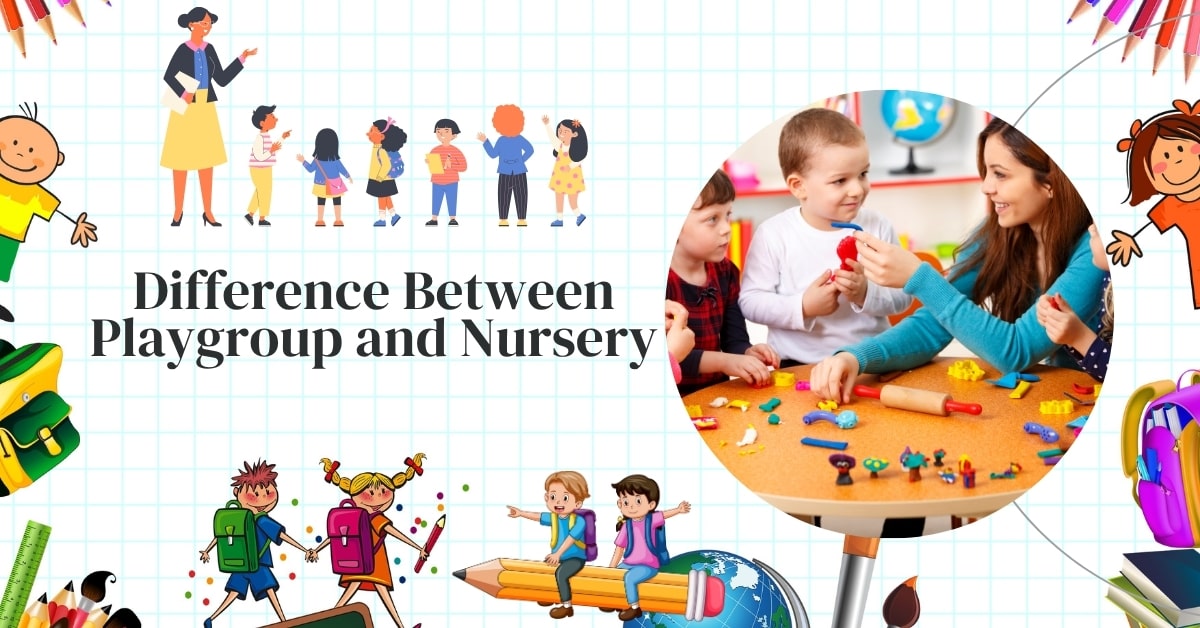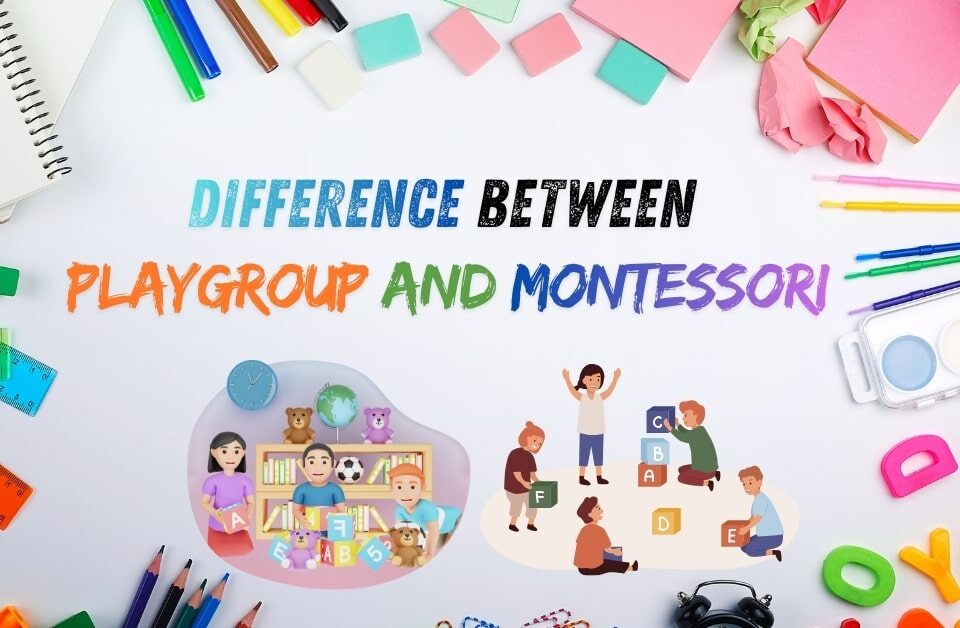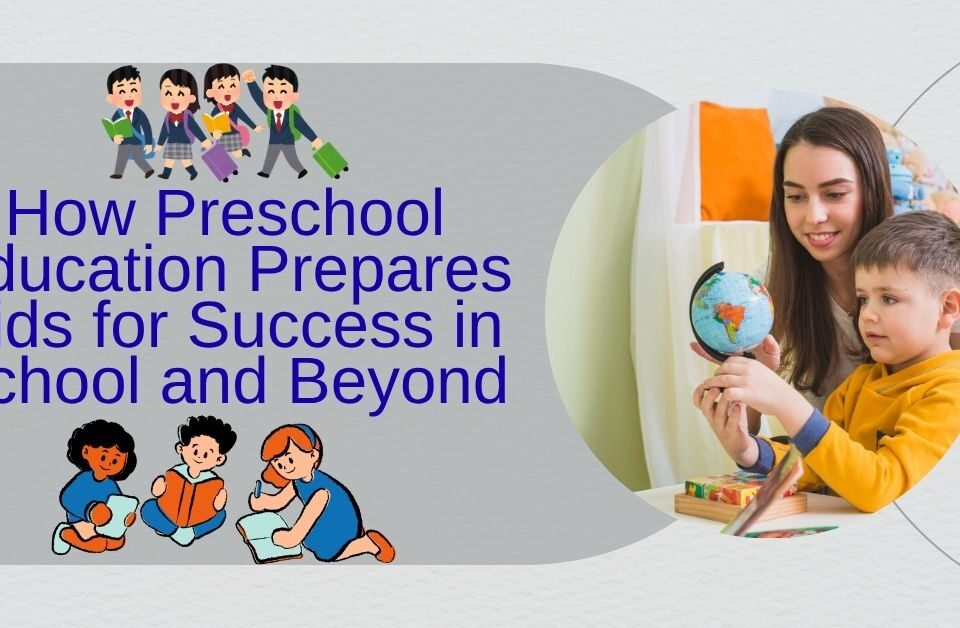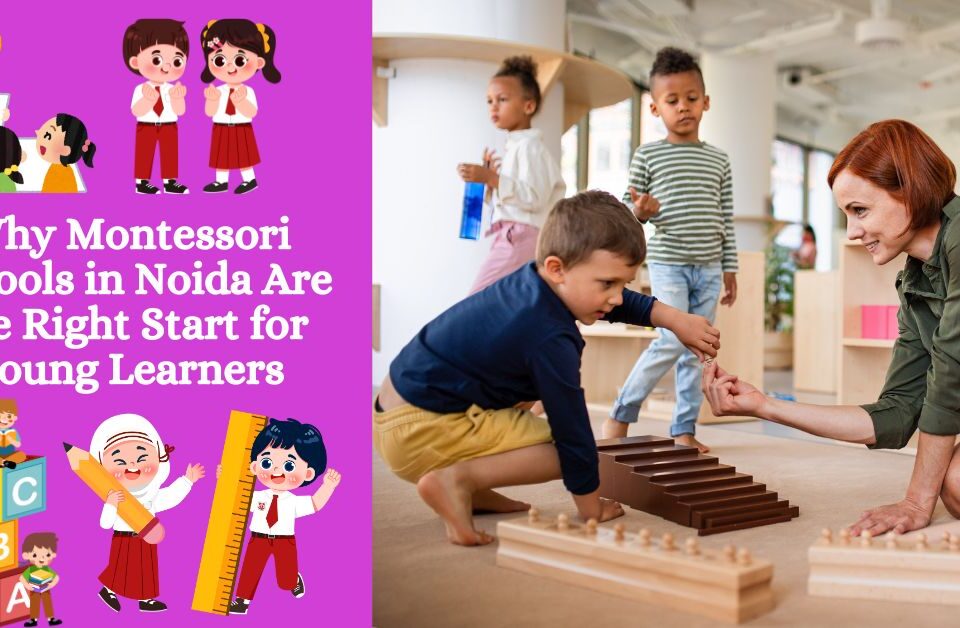
How Preschool Education Prepares Kids for Lifelong Success
October 10, 2025
Playgroup vs Montessori: Key Differences & Which Is Better for Your Child
October 28, 2025Difference Between Playgroup and Nursery: Everything Parents Need to Know
Understanding the Difference Between Playgroup and Nursery
When parents first start exploring early education options for their children, they often come across the terms playgroup and nursery. While many may be using them interchangeably, make no mistake, because there’s a difference between a playgroup and a nursery.
They actually represent different stages in your child’s growth. However, once you understand playgroup vs nursery, it will help you pick what’s right for your little one!
What Is Playgroup? Meaning, Age Group & Purpose
So, what is a playgroup? It typically refers to an introductory early childhood environment where toddlers (often aged 1.5 to 3 years) are exposed to activities and experiences that teach them to socialise, develop their senses, and get used to basic routines.
It’s important to understand that the emphasis is on exploration, interaction, and informal learning in the form of play. Thus, in a playgroup setting, children learn to share, follow simple instructions, and get comfortable being away from home.
Playgroups usually run for short hours (a few sessions per week or a few hours per day). They are also less structured than a full-blown early education class. In a nutshell, a playgroup is a stepping stone because it helps toddlers acclimatise to a group environment before they move into more structured preschool levels.
Also Read: What Is the Right Age for Play School Admission?
What Is Nursery Class? Age, Learning Goals & Structure
But then, what is a nursery class? It’s just the next rung up the ladder of education! In the Indian schooling context, children aged 3 to 4 years usually fall under the category of “nursery class”.
Here, the environment becomes more structured. That’s because children begin to engage with foundational concepts like colours, numbers, letters, shapes, and early language skills. Even the activities are arranged in a way to initiate their cognitive, motor, and socio-emotional development.
Thus, the nursery curriculum is more formal than playgroup; however, it still relies heavily on playing, storytelling, movement, and guided interaction. Nursery also helps children adjust to the routines, expectations, and transitions they’ll come across in higher preschool grades and school.
Playgroup vs Nursery: What’s the Difference?
If you’re still confused, this playgroup vs nursery discussion will definitely clear all your doubts!
Key Differences Between Playgroup and Nursery (Age, Curriculum, and Readiness)
1: Playgroup (1.5–3 years) vs Nursery (3–4 years): Understanding Age-Appropriate Learning
The playgroup age vs nursery age is very different from each other! Playgroup is for younger toddlers who are around 18 months to 3 years old. They are basically just beginning to separate from their caregivers, socialise with similar-aged kids, and explore basic sensory activities.
On the other hand, nursery usually begins from age 3 or thereabouts. This is when children can sit through slightly longer sessions, follow simple instructions, and engage with group learning.
2: From Flexible Play to Structured Learning: How Daily Routines Differ
There’s also an obvious difference in these early childhood education stages when it comes to structure and routine. In a playgroup, the schedule is looser. The focus is on free play, guided exploration, singing, and hands-on activities. These sessions may last 2-3 hours and might not be daily.
However, by the time a child reaches nursery, they’re introduced to more structure. They have to deal with mixed timings, group transitions, and class routines (circle time, activity zones, snack time, story time).
Also Read: How Preschool Education Prepares Kids for Lifelong Success
3: What Children Learn in Playgroup vs Nursery
Playgroup is primarily about social-emotional development, gross motor skills, sensory exploration, and developing comfort in a group setting. It is low on explicit academic targets.
The nursery curriculum builds on that foundation; however, it adds basic education concepts (letters, phonetics), sense of numbers, shapes and patterns, storytelling, and guided activities.
This prepares the child for higher academic levels. The nursery curriculum may also introduce simple assessments or progress tracking.
4: How Teacher Involvement Changes Between Playgroup and Nursery
In playgroups, the caregivers or supervisors often act more as playing partners and observers instead of actively instructing the kids. Instead, they are responsible for gently guiding the children as they explore.
The environment is forgiving, experimental, and child-led. In contrast, in a nursery class, the teacher takes on a more active instructional role. There is more planning, assessment, and structure.
The teacher may lead group lessons, monitor individual progress, and gradually introduce routines to help the children adapt and adjust to the expectations of a classroom setting.
5: Preparing for the Next Stage: How Each Program Supports Development
By the end of playgroup, children usually become comfortable in group settings, start interacting with their classmates, respond to simple instructions, and begin developing their language and motor skills.
However, the outcome is slightly different at the end of nursery. In this case, they become better prepared to enter pre-primary or kindergarten levels.
They are also able to sit, listen, engage, manage transitions, and begin foundational literacy and numeracy. Thus, the nursery acts as a bridge between free play settings and more formal schooling.
Also Read: Why Preschool Education is Important?
How to Choose Between Playgroup and Nursery for Your Child: Practical Tips Every Parent Should Know
Now, the difficult part is choosing what’s right for your child. However, now that you’ve had the preschool levels explained, these tips will help you make a swift decision:
- Observe your child’s temperament. If your child is clingy yet hesitant with new environments, starting with a playgroup will give them time to adjust.
- Look for a school that offers multiple educational levels. A suitable institution will be one that smoothly rolls its students from playgroup to nursery.
- Visit classrooms. Notice whether the playgroup rooms feel warm, welcoming, and flexible, and whether the nursery rooms show gentle structure without rigidity.
- Ask about teacher qualifications & ratios. Even at the playgroup level, caregivers should have training in the early years.
- Watch for progress, not pressure. The goal is growth over speed: can your child now stay in class, respond to prompts, and interact? That’s success!
Also Read: Tips to Choose the Right Preschool for Your Child
Final Thoughts: Why Playgroup and Nursery Are Equally Important in Early Education
Some parents might wonder: why not skip playgroup and jump straight to nursery? However, there’s a difference between playgroup and nursery and the primary one being readiness and development.
Playgroup gives extremely young children the breathing room to adapt to separation, rhythm, and social settings before being asked to follow more structured routines. It acts as a buffer and allows children to build confidence, emotional security, and comfort in groups.
In playgroup vs nursery, the latter takes the former’s foundation and adds more cognitive and social skills. Thus, both educational stages are equally important and necessary for your child!
Finding the Right Preschool in Noida & Greater Noida
JBM Smart Start is recognised as one of the best preschools in Noida & Greater Noida. The faculty is committed to offering quality education so that your child is well prepared for higher educational levels. Enrol now!
Frequently Asked Questions About Playgroup and Nursery
Q1: What is a playgroup exactly?
Ans: Playgroup is an early childhood program for toddlers (around 1.5-3 years old). It focuses on exploring freely, developing sensory skills, socialising, and familiarising children with group settings.
Q2: What is a nursery class?
Ans: A nursery class is an early formal educational stage for children around 3 to 4 years old. It can be considered the next educational stage after playgroup. It combines structured play, early literacy/numeracy, and routines to prepare the kids for formal schooling.
Q3: What is the playgroup age vs nursery age?
Ans: Typically, a playgroup is for children aged 1.5 to 3 years. On the other hand, a nursery is for children aged 3 to 4. However, many schools may follow a different age criterion and rely on the readiness of the individual child.
Q4: Is playgroup beneficial, or could I wait until nursery?
Ans: Playgroup offers a gentle start for your children. It helps them to adapt emotionally, socially, and academically without overwhelming them. You can skip playgroup if you want, but children might face adjustment stress when they get enrolled in nursery.
Q5: How does the nursery curriculum differ from playgroup?
Ans: Playgroup focuses on playing freely, sensory experiences, and social interaction. On the other hand, nursery introduces structured learning zones, guided activities, early literacy & numeracy exposure, and more deliberate teacher-led engagement.




